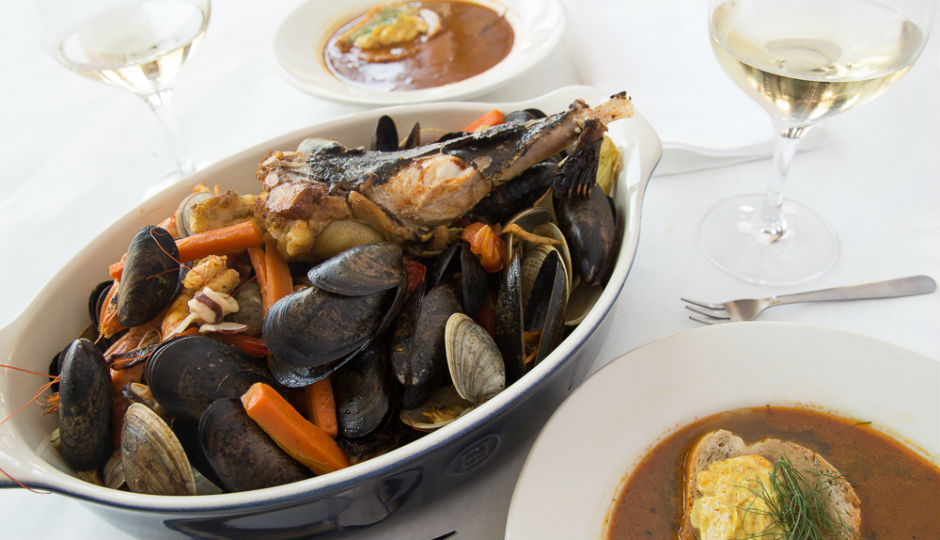Cauliflower After Dark: Neuf Reviewed

The Bouillabaisse at Neuf / Neuf
I was excited when Joncarl Lachman told me his next restaurant was going to be a French/North African concept. A little bit bistro, he said, but with the techniques and textures of Morocco, Tunisia and Algeria. A little gin at the bar, or maybe French 75’s drunk fast so the bubbles get right up in your nose. Flavors like the Marrakesh night market lit on fire.
And I was into it because Neuf was new—high-end North African food not being something you see much around Philadelphia—and because Lachman is good at doing new. He’s committed to turning geopolitical oddities (like Dutch/Scandinavian regional modernism at Noord, or a one-night-only rijsttafel pop-up dinner in collaboration with the crew from the Indonesian workingman’s cafe, Hardena) into satisfying, comforting dinners where the curation of the menu is nearly as important as how it all comes together on the table.
So when he put together his crew at Neuf, I wasn’t worried. When he got champion barman Jesse Cornell to leave Vesper and come shake cocktails here (and pitch for Lebanese syrah and international beers like Efes, a Turkish pilsner that drinks nice against the blunt heat of chilies and cumin), I felt comfortable that Lachman was paying close attention to the alcoholic side of the operation as well.
And really, everything was going nicely in the run-up. There was a good test dinner at Drexel. The space, with its whitewashed walls, oxblood accents, Middle Eastern knick-knackery and dark wood trim, seemed to gush warmth. Its placement, too, right in the heart of the Italian Market, seemed perfectly idiosyncratic—like of course that’s where you’d go for bisteeya after dark, for cauliflower with charmoula or quail stuffed with dates; to sit at the table in the big bay window in front, looking out over 9th Street while waiting for your endive salad (so classically Parisian, with pear and walnuts, frisée and Roquefort) to arrive.
But then it opened, and something about the place just felt … off.
The menu, in its final form, was unexciting. Neutered. The bisteeya vanished pretty quickly, and specials started going up on the chalkboard next to the bar. And while the kitchen offered a few dishes that looked like interesting collisions between European and Middle Eastern culinary traditions (like pan-roasted squab over fava bean bissara with fingerling potatoes and a quince gastrique), there were even more that read like one-note covers. Sure, there were tajines and shakshuka. There was a goat leg. But very few dishes (on paper, anyway) seemed to have the mash-up poetry and excitement I’d been hoping for.
Which would have been fine—the kind of thing where a menu’s descriptions just can’t possibly do the dishes justice, which happens a lot. Except that once I made it to the table, the kitchen proved to be equally uninspired.
There were hits, sure. That shakshuka was probably one of the better ones I’ve had—the balance between tomato sweetness and chili heat perfect, especially when smoothed out by the slickness of the poached egg, and with just enough sour feta cheese to make you chase the taste of it all the way to the bottom of the bowl. The bouillabaisse was a bounty of sweet shrimp and clams, fish and toasted bread with rouille, all swimming in a rich, fragrant saffron broth. There’s a stuffed quail that comes resting atop a bowl of Algerian harira, and while the quail was only okay, the soup itself (a rich vegetable broth with chunky, soft carrots and onions and tender chickpeas, all fragrant with spices) was the real star.
And the bread (which, yes, I know is just a small thing) was excellent—crumbly, crisp, perfect with the handful of olives and soft butter that comes with it. To sit at the curved bar, the sad harmonies and buzzing pipes of Middle Eastern music dripping down from the ceiling, and eat great bread and olives in the dim light and flickering candle glow—those were my favorite moments at Neuf.
But so much of the rest of the menu was surprisingly gentle. Like Lachman had taken all the rough energy born of the friction between the canonical French tradition and the bold, bright spices of North Africa and turned the volume down across the board. The roasted cauliflower was nice, preserving and highlighting the woody, almost nutty flavor of my favorite brassica, but the lemon, the garlic, the cumin and clove of the charmoula was disappearingly subtle. The fennel three ways was ugly and dull—so much beige on a single plate. And the three presentations of the (overused, too often disrespected) fennel bulb tasted somehow identical, whether pureed, done as a confit, or shaved raw in a frisée salad. The textures were different (obviously), but each of the three versions had the same lingering, astringent vegetable flavor as fennel eaten raw, which made me glad for the distraction of the little grapefruit segments scattered on the salad—and I am never happy to see grapefruit in anything that’s not a tiki drink.
The prawns en papillotte were perfectly cooked and served un-fussily in what looked like the bottom half of a brass teapot lined with the foil (the “en papillotte”) in which they’d been cooked, but they seemed lonely, with just a few limp slivered onions and a couple cherry tomatoes for company. Worse, the ras el hanout they’d been rubbed with—that most Moroccan of spice blends—came through as barely a whisper. What ought to have been a fragrant, warm, powerful mess of cinnamon and coriander, cardamom, paprika and a dozen other spices tasted only of dusty cumin and otherwise nothing much at all.
The service was knowledgeable on the floor and welcoming at the bar, but Lachman was absent from the restaurant when I was there, which didn’t help, because he’s among the most charming owners in the city, moving around dining rooms in an invisible bubble of warmth and infectious joy. I can imagine Neuf being the kind of place that only grows brighter and more charming with a big, loud, raucous crowd all laughing and talking and scraping plates and clinking glasses—but that’s only a guess, because I’ve yet to experience the room even half full. Stumbling upon the warm yellow glow of Neuf’s windows on 9th Street can seem a bit magical when the Italian Market is otherwise deserted (which is to say pretty much every hour that Neuf is open), but to then push through the doors and find the dining room equally desolate is disheartening.
But honestly, none of that matters all that much to me. A boisterous crowd, a busy bar, a beaming host walking the floor—they don’t mean a damn when the kitchen isn’t delivering on the promise of the concept.
And that’s the problem with Neuf. There’s a disconnect somewhere—an incomplete vision of what the restaurant is trying to be, a sense of imperfect focus, of small details overlooked (or not properly communicated) in the kitchen. Dishes lack the spark that might elevate them to the level Lachman appears to be aiming for. I have a feeling there’s a great restaurant hiding somewhere in his vision for Neuf, but he and his crew haven’t found it yet.
Stars: 2 stars – Come if you’re in the neighborhood.
Neuf [Foobooz]


